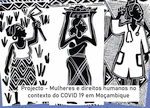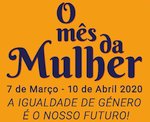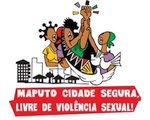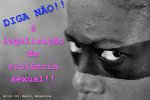Social Movements and Violence against Women in Mozambique: Landmarks on a Journey
Ana Maria Loforte
Recent decades have seen the growth of social movements involving collective actions by non-governmental organizations in Mozambique. The purpose of these movements is to mobilize material and symbolic resources for the definition of transformation strategies intended to strengthen the power of women. Creating new points of interpretation, their focus is not just a collective response manifest tensions and structural inequalities. Much of the significance of their action is to reveal certain conflicts to public opinion, to explain them and to make them explicit.
The purpose of this article, based on an analysis of interventions by some NGOs, in particular WLSA Mozambique, is to identify their role in the process of de-legitimizing violence against women. Recent campaigns and the social, political and legal responses are, in reality, the final, public and visible product of a broad process of redefining violence against women, such that it is no longer a personal drama but a social problem.
Starting by questioning the structural aspects of subordination, the demands for an end to violence sought to demonstrate its most brutal manifestations, those that on the symbolic plane represent the most obvious aspect of a profoundly oppressive and hence unacceptable gender order.
Social movements and collective action
We start this analysis with the suggestion that these movements are a form of collective action, in that they develop common activities to achieve shared ends and call on solidarity to promote social changes. We believe that the social characteristics that can lead to this term (collective action) center on:
- Actions that involve simultaneously a group of individuals or groups;
- Actions that imply a field of social relations;
- The people involved attribute meaning to their actions (Melucci, 1987).
We start with the assumption that NGOs define as unfair and the object of social change, a situation that is usually legitimized by cultural tradition and customs. So we concentrate on identifying forms of participation by collective actors in social intervention. We sought inspiration in Goffman (1987:149) who says that “a formal organization can be defined as a system of activities that are intentionally coordinated and intended to provoke some specific and global objectives. The anticipated product can be: material artifacts, services, decisions and information”.
When analyzing this definition, various aspects are evident and enable us to make assumptions about: (i) the discursive practices in organizations that configure specific and global objectives; (ii) the non-discursive practices that take shape in intentionally coordinated activities; (iii) a product that provides access to information.
Discursive practices in the process of reconceptualising violence
The phenomenon of violence is more than just violent events. It leads to a perception of violence against women as a social phenomenon that can be subject to discursive analysis. It is thus important to analyze the underlying theoretical frameworks and who intervenes in denouncing the problem.
In works published by WLSA, arising from research on Violence Against Women, there are points of reference, concepts that gave new meaning to old problems, such as the exercise of domestic violence. Gender as a concept achieves prominence and various itineraries, as it is a crucial analytical category to explain structural inequalities. Incorporating this concept emphasizes the social and symbolic dimension of differences as opposed to an explanatory model that focuses on male and female biological differences.
But discussing gender resulted in the need to revise and debates other concepts inherent to it such as power and its variables. In the research situation, gender relations are power relations expressed through mechanisms of a material and symbolic nature. Connell (1997) argues that violence is structured by gender relations because of inequality. Moreover, it is a structure of inequality involving a lack of continuous social resources that generates and organizes violence (Osório and Temba, 2001:44). In explaining the phenomenon and its social causes, WLSA also identified the important role played by coercion in a patriarchal system, whether in the form of a mere threat or the latent possibility, either of which means constant intimidation.
The patriarchal ideology is so firmly interiorized, and its forms of socialization are so perfect and subtle, that the resulting structural coercion leads to a situation where “the fear of those susceptible to being victims of violence, itself operates as a powerful control mechanism. It is sufficient to see how often women maintain their self-control over their behavior, and even their movements, to avoid ending up in a risk situation” (Arthur and Mejia, 2005).
This aspect brings out into the open the fact that violence is a strategy of male domination because of the fear it instills in women. Nevertheless, its feature of being considered natural means that violence does not have to be constantly justified. From a Foucaultian perspective, however, it’s emphasized that opposition between dominators and dominated is not rigid, and that various kinds of resistance are shaped as producers of the same mechanism: women are not passive victims of violence. Consequently, the work Rebuilding Lives: Strategies of women who survived domestic violence “emphasizes forms of resistance and the many varied strategies used to avoid violence, preserve dignity, protect the children, and ultimately to restart their lives” (Arthur and Mejia, 2007).
This book, that describes the social experience of some women, shows clearly the struggle to reduce the forms of their daily exploitation, their craving for a world with less unequal relationships where, under specific conditions and within particular structures, the female acquires her own, significant space.
In truth, as Ponce say (1995) “socializing processes provide women with versatile elements that enable them to manipulate reality according to the conditions of their own existence, providing them with tools to maximize their survival capacities and to move within the social mark from subordination to equality”.
In addition, the discourse present in research reports subverts the ancestral and dominant cultural code that always explains violence against a woman as the result of the perpetrator’s weakness, when they claim “being violent with women is not part of an individual’s pathology, but rather the “effect of the structure”, according to Echene (2003). This perception is confirmed by an aggressor who states, “I’m not very normal, I didn’t do anything wrong”. (Arthur and Mejia, 2005).
But making the phenomenon of violence against women visible required articulation and coordination.
Intentionally coordinated activities
In the first moment, it was important to define the situation of violence as problematical and unlawful. A second moment was marked by denunciation of the causes of the situation, be they cultural, economic or political. But proposing alternative solutions has been crucial. It is not enough to announce that a system is unjust; it is vital to spread the idea that the situation can be changed, and this requires respect for the fundamental rights of individuals. Consequently, the need to observe and value the human rights of women has been a fundamental and indispensable component in the appeal for the eradication of discriminatory practices.
The “androcratic model that influences Human Rights law, considered neutral, universal and effective, has resulted in violations of women’s rights going unpunished and the legitimization of subordination” (Andrade et al., 2000:40).
The engagement of NGOs led to the creation of spaces for discussion, interaction and dialogue involving social actors who identified with this cause. Some of them developed around the necessary articulation between academia, research and policy, with the possibility of empowering groups whose voices and actions had been silenced. Through advocacy and lobbying activities they have been instrumental in bringing the issue of violence against women to today’s agenda.
Their interventions found the ideal instrument in the government’s five-year program that speaks of the need to protect the human rights of women in order to raise their awareness, and that of the community, about their rights, including the right to non-violence1.
In 1998 some actors who until then had had little contact with each other, came together as a coalition for the All Against Violence campaign, to advocate and develop the necessary strategic measures. The All Against Violence campaign had four aspects:
- Direct support for victims of domestic violence, women and men
- Public education and counseling for various social groups
- Training and education on human rights and gender inequalities
- Research on domestic violence against women.
Later, a key moment in this process was the preparation of the law on violence against women. This proposal, strongly inspired by the Constitution of the Republic and the international instruments ratified by Mozambique, namely CEDAW, subscribed the idea that only by recognizing its structural nature, the fact that it is the result of gender inequalities in the family, is it possible to fight domestic violence.
There were various activities on controlling and preventing violence, and simultaneously a continuous information campaign, raising awareness and educating people, in collaboration with various government sectors. In particular, there was a national campaign against the traffic and sexual abuse of minors led by civil society; assistance to victims of domestic violence was improved and they were helped to access the network of NGO and line ministry legal, medical and psychological services.
The year 2007 saw the creation of the movement for approval of the Bill Against Domestic Violence. Among other aspects its manifesto made the following appeals:
- that the law against domestic violence be approved;
- that domestic violence, in particular violence against women, should be part of the agenda of members of the government, the legislature and those applying the law in Mozambique.
Driving the collective action, the NGO coalition alerted to the seriousness of the situation, and helped to “dramatize” it, the term used here with the meaning given by Goffman (1974), awakening the awareness of a set of people to share the same opinion on a controversial issue.
Fighting for the recognition of women’s rights became an imperative. The government was pressured to introduce effective mechanisms for accountability on gender equality and, among others, to comply with the CEDAW recommendations, taking measures to eliminate discrimination against women at all levels of society and to change laws or cultural and social practices that constitute obstacles to this equality (article 2 of CEDAW).
Various NGOs working in the field of women’s human rights prepared a Shadow Report that provided an alternative vision to the first government report on compliance with CEDAW2. They thus had a “sentinel” role in relation to the government’s actions, emphasizing progress and constraints on activities aimed at gender equality and eradicating discriminatory practices. They formulated a set of very persuasive and useful recommendations on interventions to remove all legislation, rules and institutional practices that are an assault on women’s rights.
In the case of violence in particular, the recommendations argued that “it is important to approve the bill in order to fill legal gaps in fighting one of the problems that is most prejudicial to women’s exercise of their human rights.”.
In addition, at a more general level, it was argued that “in its review of the Penal Code and Inheritance Law the government must ensure that the principal of non-discrimination against women is guaranteed, not only by eliminating dispositions that openly discriminate against them, but by eliminating all the prejudice and sexist values implicit in these laws”.
Their pronouncements helped the Committee on the Elimination of Discrimination against Women to invite the Mozambican State to ensure that the provisions of the convention were supported and their application accelerated3.
Access to information
As regards access to and the dissemination of information, posters received special attention. They contained explicit information, as follows:
- Domestic violence is an attack against women’s human rights;
- Violence against women and children is a human rights violation
- Women have the right to guarantees for their physical integrity and control over their bodies
- Domestic violence is torture for women and can kill
- The Penal Code must criminalize marital rape.
By once again focusing their messages on human rights, the organizations consolidated the idea that the solution to the problem does not only lie with women. Responsibility is broad and complex, involving action by the State to safeguard women’s human rights.
By specifying the means and ends of violence against women, the NGOs emphasized that its purpose is to maintain subordination in gender relations, but women have decision-making capacity and must be given autonomy and the capacity to be and to act.
Conclusion
In our overview of the framework for social movements’ interpretation of the phenomenon of domestic violence against women, with the main focus on WLSA, we found that their theoretical contribution has been to conceptualize correctly – as conflict and as the product of unequal gender relations – aspects that are sometimes considered natural, immutable and rooted in tradition. The de-legitimization process emphasizes that violence is the result of the normative discrimination behavior inscribed in power relations, and as such this is a vital area in the fight for women’s human rights.
By making the collective actions of NGOs visible, by expanding their field of social subjects, they were not just seeking to denounce anomalous situations; they were also publicizing ill-treatment that, given the sharp rise in cases, had acquired the status of a social problem. During this period, they ended up providing spaces for encounters with other men and women, real spaces of differentiation and of seeking the denaturalization of violence. This whole process gave new meaning to the phenomenon.
These initiatives, aimed at addressing strategic gender needs, transformed the NGOs. They were also strengthened by the need to monitor the constant guidelines in the international instruments ratified. In addition, at the same time as they were successfully achieving condemnation of domestic violence against women and denouncing the prevailing patriarchal order, the hegemonic identity of the perpetrators was destabilized. In recent years, the NGOs involved in social movements have become the center of material and symbolic cooperation under the slogan “Violence against women is not love. Enough is Enough”.
Notes
- Moçambique (2005). Programa do Governo para 2005-2009. Maputo.
- Shadow Report on the “Stage of implementation of CEDAW in Mozambique”, with reference to the Government’s report: “National Report on the Convention for the Elimination of all Forms of Discrimination against Women – CEDAW, 2003” submitted to the CEDAW Committee in its 38th Session, May-June 2007. Maputo.
- Committee on the Elimination of Discrimination against Women, Concluding Comments of the Committee on the Elimination of Discrimination against Women: Mozambique, 38th session, 14 May – 1 June 2007.
References:
ANDRADE, Ximena; OSÓRIO, Conceição; TRINDADE, João Carlos (2000). Direitos humanos das mulheres em quatro tópicos. Maputo: WLSA Moçambique.
ARTHUR, Maria José; MEJIA, Margarita (2005). Violência doméstica: a fala dos agressores. In: Outras Vozes, nº 11.
ARTHUR, Maria José; MEJIA, Margarita (2007). Rebuilding lives. Strategies of women who survived domestic violence. Maputo: WLSA Moçambique.
CONNELL, Robert (1997). La organización social de la masculinidad. In: Teresa Valdes y José Olavarria (eds), Masculinidades: Poder y crisis. Santiago. Ediciones de las Mujeres n.24. Isis Internacional.
ECHÈNE, Agnès (2003). Violence et conjugalité. In : Les Pénélopes. (http://ladivecie.free.fr/article.php3?id_article=36)
GOFFMAN, Erving (1974). Frame analysis. An essay on the organization of experience. Cambridge: Cambridge University Press.
GOFFMAN, Erving (1987). Manicómios, prisões e conventos. São Paulo: Editora Perspectiva.
MELUCCI, Alberto (1994). Qué hay de nuevo en los movimientos sociais. In: E. Larana y J. Gusfieled (eds), Los nuevos movimientos sociales. Madrid: CIS
OSÓRIO, Conceição; ANDRADE, Ximena; TEMBA, Eulália; CRISTIANO JOSÉ, André; LEVI, Benvinda (2001). Poder e Violência. Homicídio e Femicídio em Moçambique. Maputo: WLSA Moçambique.
PONCE, Martha (1995). Trabalho, poder e sexualidade: história e valores femininos. In: Cadernos Pagu, nº 5.
* * *







 Information in English
Information in English



















